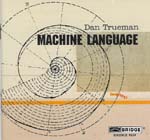Even though it is avant-garde music, even though there are somber and dark moments, this collection by Dan Trueman mostly reflects joy. Trueman’s favorite musical activity, he says, is playing violin with friends in chamber music. All the music here was written between 1999 and 2003, a time when he had just discovered how to integrate his new interest, the six-string electric violin, with laptop computer, into chamber music. The listener gets a sense of things clicking into place for Trueman as the collection traverses several different chamber combinations, mostly strings. Trueman is featured in four of the six pieces.
The title piece, Machine Language, for violin, electric violin, cello, and percussion, is a whimsical imagining of the language that might be spoken by imaginary “species” that “evolve” from computer simulations of evolutionary hypotheses. Since this piece springs from the model of “punctuated equilibrium”, the music tends to stay in a mood, subsequently altered by addition or subtraction of musical “genes” in quick order to create another “animal”.
Traps, for the Daedalus String Quartet plus Trueman, is concerned with an electronic process that unexpectedly adds dissonance to a D minor chord. Counterfeit Curio is for the Non Sequitur ensemble plus Trueman’s electric violin. It gradually “reconstructs” an old recording, except that the old scratchy record turns out to be a fake newly created by Trueman. Still is a trio for violin, electric violin, and cello, and it’s full of gestures that begin to disintegrate and expire in a stunned silence. Trueman completed the work on September 11, 2001 and was holding the finished score for the first time when the news of the terrorist attacks came in. The performance reflects his eerie sense of realization that this piece about collapse and destruction anticipated the mood of that day.
There are two pieces without electronic instruments. Spring Rhythm, for string quartet, paraphrases the name of a Jackson Pollack painting while the music attempts to capture Pollack’s sense of random energy. The process “spatters” an initial texture of notes, then drops a part and replaces it with a different part, and so forth until the music is completely changed. A Cappella is a dark-hued meditative piece that uses the singing tone of cellos to make the effect of a vocal chorus. Once again, Bridge Records has presented a composer from the East Coast scene whose music is not only unique and intelligent, but also deserves attention.
































